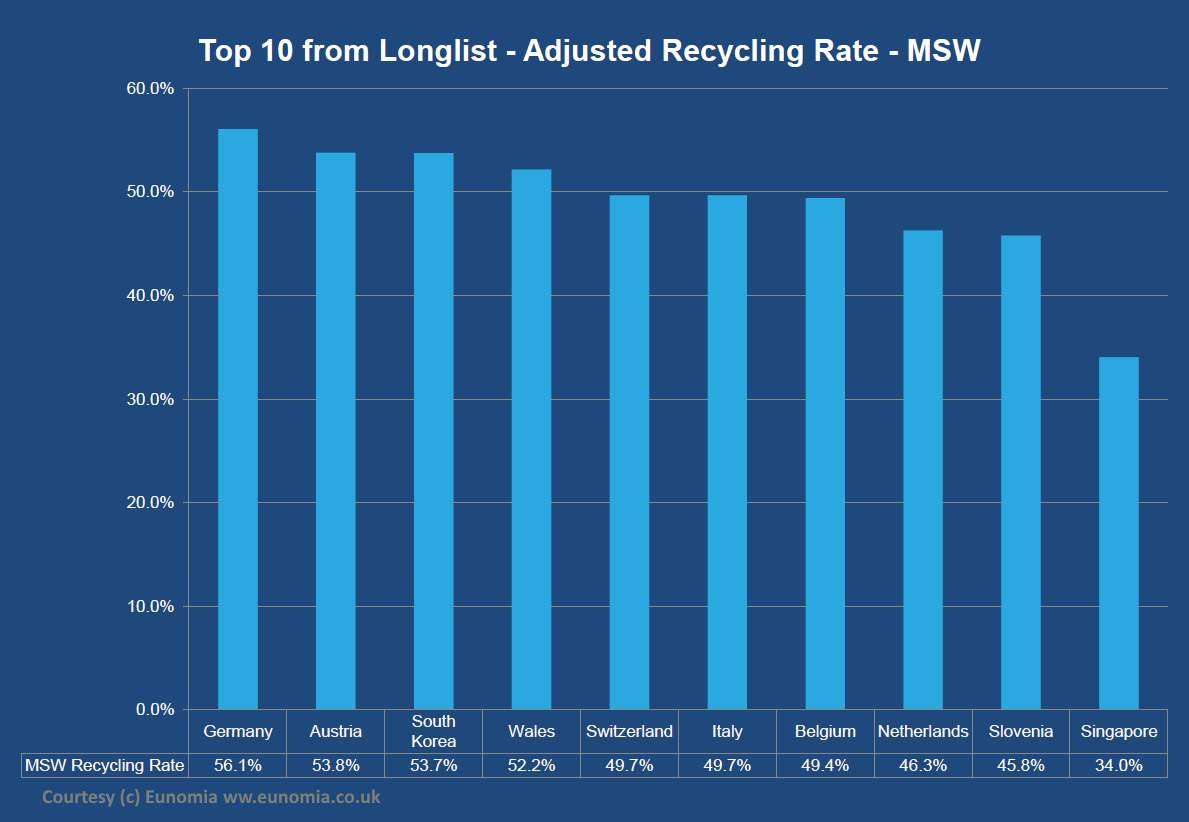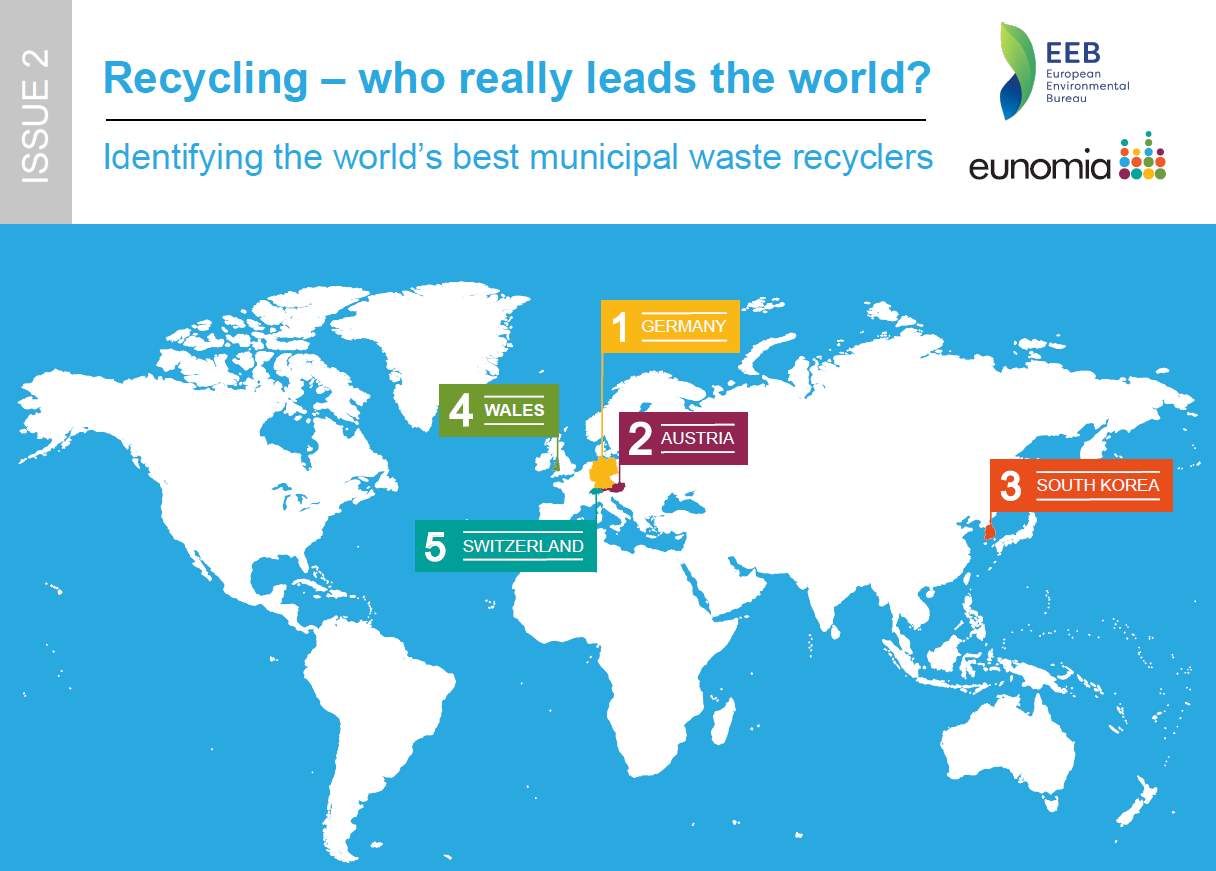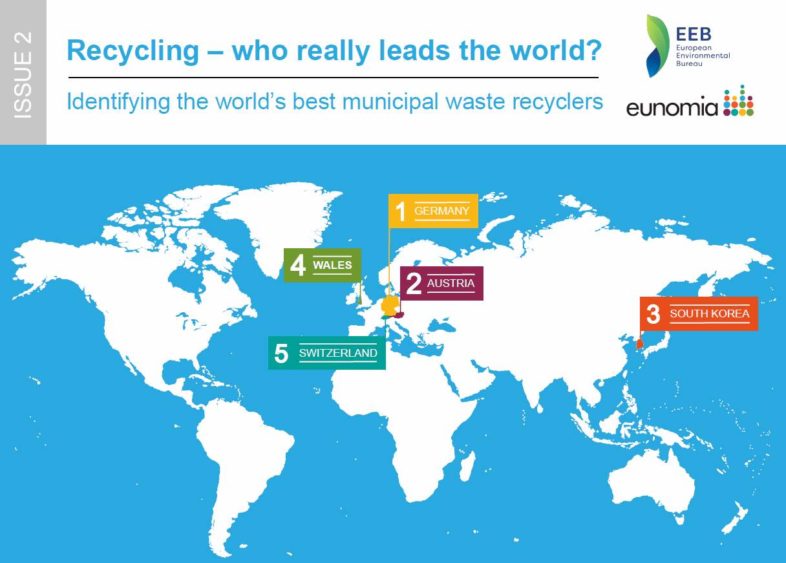World recycling statistics supplied by governments vary in how they classify and record recycling rates, so we provide our Top 5 List of Recycling Countries 2018, as adjusted recycling rates to reveal the true top recycling nations. Additionally, recycling rates are also a delusion for a number of countries which after adjustment are shown to minimise, re-use, and recycle far less than reported. States should also seek to minimise waste, and if not re-use it, only recycling that waste if the preceding 2 hierarchical and preferred waste management options, prove unfeasible.
To redress the World Recycling Statistics imbalance for the countries inadvertently overstating their recycling figures, we have listed below the Top 5 List of Recycling Countries 2018.
For those of you that like to watch videos, we also recorded a video on the “Top 5 List of Recycling Countries 2018”, which we have added below. Watch the video, BUT don't forget to return and scroll down to read more AFTER you have seen the video, because we were unable to include everything of interest in the video.
These are shown in accordance with the adjusted tables published by the respected environmental consultancy Eunomia Research & Consulting. These are available in its update on previous work, and were published in a new report March 2017 called ‘Recycling – Who really leads the world?’ (Issue 2)
For this report we understand that Eunomia teamed up with the European Environmental Bureau (EEB). And, the full pdf report also presents calculated adjusted municipal waste recycling rates for the top 10 countries to provide a more accurate comparison between them.
The revised top 5 List of Recycling Countries 2018 league table, list is as follows:
- Germany retain top spot with 56 per cent,
- Austria (54 per cent) and,
- South Korea (54 per cent)
- Wales in fourth place (52 per cent).
- Switzerland (49.7).

This has many changes to what you would see if you were looking at the recycling rates reported by each country.
The un-adjusted top three is different, with:
- Germany (66 per cent),
- Wales (64 per cent) and
- Singapore (61 per cent).

Which List Top List of Recycling Countries 2018 is Correct?
The revised top 10 acknowledges the differences in how certain aspects are accounted for or not in the nationally reported figures, such as inclusion of Construction and Demolition (C&D) waste, inclusion of Commercial and Industrial (C&I) waste, Incinerator Bottom Ash (IBA) and metals recovered from IBA, contamination within dry recycling and biowaste, inputs and outputs of mechanical and biological treatment and recycling processing losses.
Meanwhile, England continues to languish back in 18th position for reported recycling rates, with a 42.8 per cent rate, while it doesn’t make the top 10 for adjusted figures, with all of the top 10 countries showing adjusted rates of 50 per cent or more.
Learning Lessons from the Best Countries List of Recycling 2018
After looking at waste management policy, legislation and collection services, the report states that high performance is at least in part down to comprehensive recycling schemes (including mandatory separate collection of dry materials and biowaste), clear performance targets and policy objectives, funding for recycling through government or extended producer responsibility (EPR) schemes, and financial and behavioural incentives to directly and indirectly encourage citizens to recycle.
Wales will be disappointed that it is no longer in the Top 3 List of Recycling Countries 2018. Its adjusted recycling rate sees it drop out of the top three, some way below its reported 64 per cent for 2017. This ambitious target was achieved three years before the date the Welsh government had aimed at.
Much better news is that Eunomia’s report forecasts that when the existing rate of improvement in the national recycling rate is projcted forward, it shows that Wales could overtake Germany in the next few years.
Surprisingly, this could occur for both reported and adjusted recycling rates, as soon as 2018. At the same time, other European nations could be incentivised to catch up, once the EU’s Circular Economy Package is finalised, which is expected to see a target recycling rate of around 65 per cent for 2030. (February 2018 – the EU’s Circular Economy Package has now been agreed, and the EU is now waiting for the results to be published.)
Commenting on the report, Rob Gillies, Eunomia Managing Consultant and report author, said:
“What’s interesting is that when ranked based on reported recycling rates, the winners are clear, whereas after making adjustments for different measurement methods the top recyclers are much closer together, so the top spot is all to play for if countries want to be ambitious.”
“It’s important to note this research has been carried out so we can identify who the real leaders in recycling are, to share best practice by shining a spotlight on what these countries are doing. We also hope that this will help progress the debate on how best to measure ‘real’ recycling, in line with the principles of the waste hierarchy, in a way that is as consistent as possible within Europe and further afield.”
The discussion on how best to measure recycling is a pertinent one, and forms the basis of one of the disagreements over the Circular Economy Package.
The current method counts how much waste enters the recycling process, a calculation favoured by the European Commission. Germany is among the member states that has stated preference for a rate that deducts a ‘standard loss rate’ (which would vary from member state to member state), from the figure entering the recycling process. They argue that this would reflect the quantities of material that does not actually get recycling, and so create a more accurate picture of recycling in the EU.
“This kind of ground-breaking research tells us what EU countries really need to do to achieve higher recycling rates, which require proper collection and recycling of biowaste,” said Stéphane Arditi, Policy Manager on Circular Economy, Products and Waste for the EEB. “It also tells in a truly circular economy there can be no room for incineration of valuable resources that could instead be actually recycled. The fact that some countries have increased recycling rates by 35 percentage points in under 15 years shows that all member states can achieve the new EU recycling targets.”
The ‘Recycling – Who really leads the world? (Issue 2)’ report can be read and downloaded on Eunomia’s website, via top recycling nations recycling less than reported
It really is surprising how contentious this (the Eunomia Consultants) report is proving.
Editor Notes:
 What appear to be the best recycling countries in the world, do not necessarily end-up being the top countries in waste management. We consider that the best recycling countries are those that show in the data that the public is recycling their household waste. This is how Eunomia has chosen this top ten best recycling countries of which we list the top 5. The latest data shows changes in the rank for 2018, which differ from the top recycling countries in 2017. Of course, identifying the worst recycling countries is hard. The very worst probably don't even submit their world recycling statistics,.
What appear to be the best recycling countries in the world, do not necessarily end-up being the top countries in waste management. We consider that the best recycling countries are those that show in the data that the public is recycling their household waste. This is how Eunomia has chosen this top ten best recycling countries of which we list the top 5. The latest data shows changes in the rank for 2018, which differ from the top recycling countries in 2017. Of course, identifying the worst recycling countries is hard. The very worst probably don't even submit their world recycling statistics,.
Certainly, all 10 recycling countries which feature in the List of Recycling Countries 2018 are achieving admirable recycling rates around the world.
Which countries have the best recycling programs? Well, when we look at the top ten recycling countries in the world it is clear that some are recycling a wide range of recyclables, whereas the worst countries for trash are limited in the types of materials they recycle. The US is lower than would be expected for a developed nation, but they are not one of the worst recycling countries.
Countries that recycle well achieve high levels of participation from the public and countries with the best recycling really do have a population which is highly aware of retaining the beauty of its environment. It is invariably the country which is highest rates of recycling, that does the best recycling, because familiarity makes perfect as they say. We say; “well-done”, to all those countries winning recycling gains year on year.
A Review of the Ebook “An Introduction to Landfill Gas Extraction Systems”
Welcome to this review for the ebook “An Introduction to Landfill Gas Extraction Systems”. This ebook is a comprehensive guide for anyone involved in landfill gas extraction design, installation, operation, and maintenance, as well as landfill gas energy from waste (EfW) projects. About the Author The author, Steve Last, provides over 50 pages of essential […]
5 Top Household Municipal Solid Waste Sorting Equipment Technologies
It is important that our readers know about the 6 top household Municipal Solid Waste sorting equipment technologies as more and more waste is diverted away from landfills for recycling, and a more sustainable circular economy grows. That's because the proper management of household municipal solid waste (MSW) is crucial for both environmental and public […]
How a Food Waste Separator Makes Disposing of Leftovers Easier
A food waste separator makes it easy to dispose of leftovers and scraps of food. This machine is usually equipped with an auger that pushes the waste into the separator unit itself. Various shaped paddles and rods in the separator press the food waste through screens. The separated material drops out as a slurry, with […]
Reuse Old Materials by Applying These Furniture Recycling Ideas
When the time comes to replace your kitchen, why not reuse (repurpose) old materials by applying these furniture recycling ideas/ tips? It's tempting to just throw the existing cabinets away and start from scratch. That's not only unnecessary, it's wasteful. That's because the majority of kitchen cabinet materials are non-recyclable. This creates a significant problem […]







This is lovely ! Kindly recommend or assist me to undergo a training on waste recycling as I am keen on learning and practicing waste recycling as an entrepreneur. Thanks .